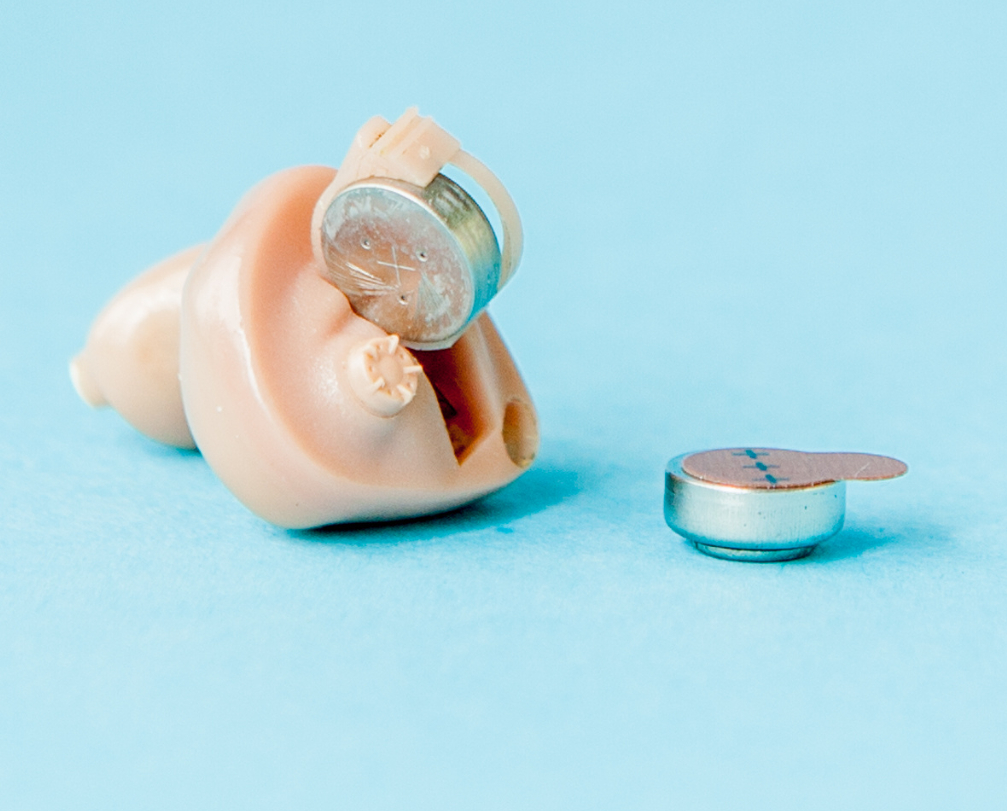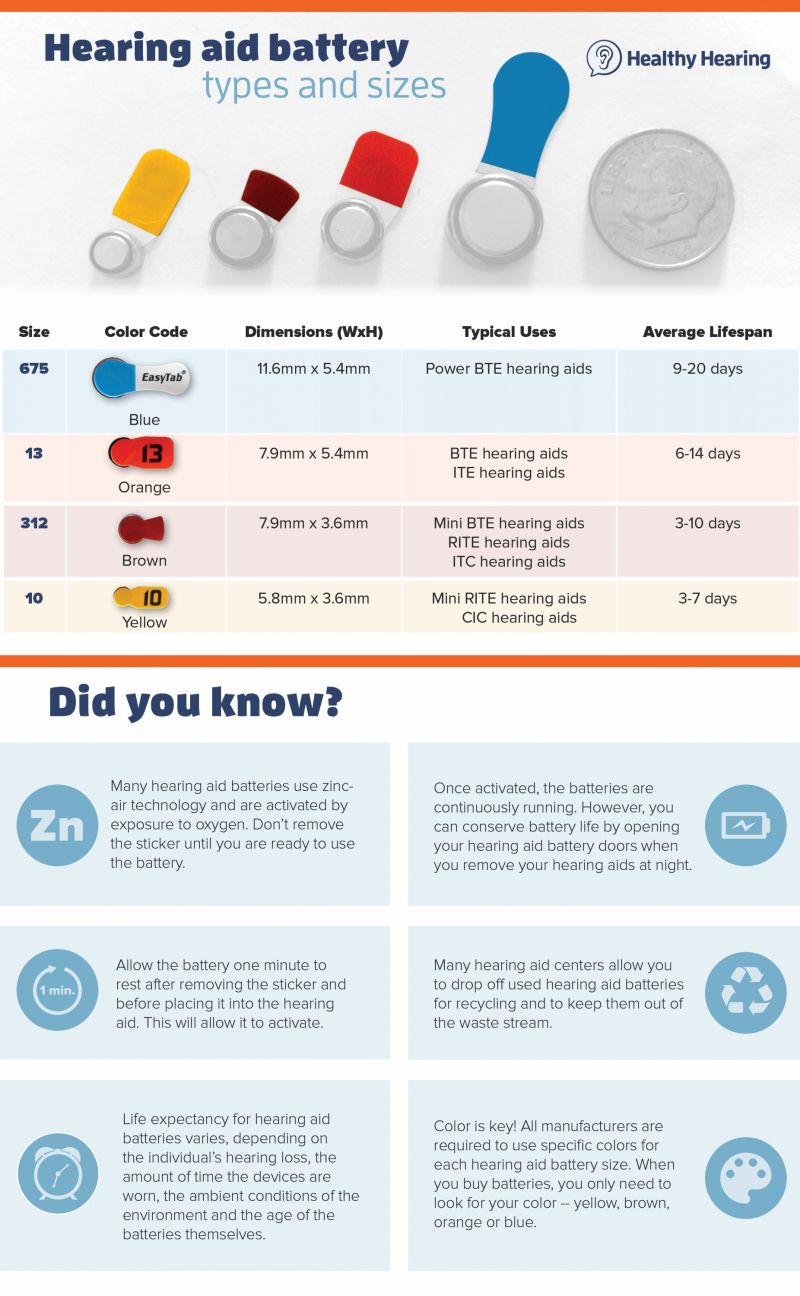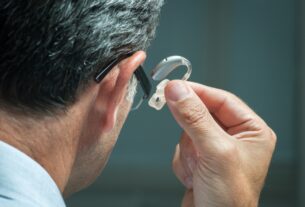Like any technological device, hearing aids run on batteries. Traditionally, most hearing aids used tiny “button” batteries that wearers had to change every few days to weeks. Now, though, many hearing aid models come with rechargeable batteries. When choosing a hearing aid, it’s a good idea to think through which battery type works best for you.
Table of Contents
Two main types of hearing aid batteries
Rechargeable batteries
_300x213.jpg)
overnight. (Image courtesy Oticon.)
Many of the latest hearing aid models come with rechargeable lithium-ion batteries. These batteries are usually recharged at night, when a hearing aid wearer takes out their hearing aids to sleep. So far, rechargeable batteries are generally only available for behind-the-ear styles of hearing aids. Rechargeable hearing aid brands on the market from manufacturers in 2021 included:
- Oticon More, Opn S, Ruby and Play
- Phonak Audeo models, Bolero, Naida and Sky
- Starkey Livio Edge AI, Livio AI, Livio and Muse iQ RIC
- ReSound ONE, ReSound LiNX Quattro and LiNX 3D
- Widex Moment
Please note other manufacturers also may offer rechargeable hearing aids; these are some of the top-sellers.
How do rechargeable hearing aids work?
Rechargeable hearing aids work very similar to smartphones—you must charge them frequently to keep them functional. Most of them come with an easy-to-use docking station. Each night, just take out “your ears,” plug them into the charger, and go to bed. By morning, they should be ready for another’s day of full use. Battery life will vary—heavy use of Bluetooth, for example, may drain the battery faster. The downside? It’s pretty simple: If you can’t charge your hearing aids, they won’t work. So they don’t work well for everyone, and that’s where hearing aids with disposable batteries come in.
More: Pros and cons of hearing aids with rechargeable batteries
Standard disposable batteries

used in hearing aids.
Before rechargeable devices became standard, all hearing aids came with disposable batteries. These days they’re a lot less common.
Zinc-air button disposable batteries, also known as “button batteries,” are the other common option. Because zinc-air batteries are air-activated, a factory-sealed sticker allows them to remain inactive until it is removed. Once peeled from the back of the battery, oxygen will interact with the zinc in the battery and “turn it on.” To get the best performance from a zinc-air battery, wait about one minute after removing the sticker to fully activate before placing it in the hearing device. Replacing the sticker will not deactivate the battery, so once the sticker is removed, the battery will remain in an active state until the power is drained.
Zinc-air batteries remain stable for up to three years when stored in a room temperature, dry environment. Storing zinc-air batteries in the refrigerator has no benefits and could cause condensation to form under the sticker, which could reduce battery life prematurely. Traditionally hearing aid batteries were produced using trace amounts of mercury to assist with conductivity and stabilize internal components, but mercury is no longer used in hearing aid batteries.

(Key: BTE=behind the ear, ITE=in the ear, RITE=receiver in the ear; ITC=in the canal; CIC=completely in the canal.)
Sizes of disposable hearing aid batteries
Hearing aids come in many different sizes and styles and with different power needs. Larger hearing aids require larger batteries. Additionally, hearing aids for people with severe or profound hearing loss typically require more power and larger batteries.
There are five sizes of hearing aid batteries available on the market. The sizes from smallest to largest are: 5, 10, 312, 13 and 675. Size 5 hearing aid batteries are rarely used. The four most common hearing aid battery sizes are all smaller than the diameter of a dime:
- Size 10 – 5.8 mm wide by 3.6 mm high
- Size 312 – 7.9 mm wide by 3.6 mm high
- Size 13 – 7.9 mm wide by 5.4 mm high
- Size 675 – 11.6 mm wide by 5.4 mm high
Color-coding for disposable hearing aid batteries
Because size differences may be hard to notice and difficult to remember, battery packaging is color-coded so finding and purchasing the correct ones is easier.
- Size 10 batteries – yellow
- Size 312 batteries – brown
- Size 13 batteries – orange
- Size 675 batteries – blue
Battery life for hearing aid batteries
Non-rechargeable hearing aid batteries can last anywhere from five to 14 days, based on a 16-hour day of wear. This is dependent upon the size of the battery and power needed by the hearing aid. Typically, smaller batteries have shorter battery life than larger ones.
The average lifespan of hearing aid batteries is as follows:
- Size 10 – three to seven days
- Size 312 – three to 10 days
- Size 13 – six to 14 days
- Size 675 – nine to 20 days
If you are experiencing shortened battery life, there may be an issue with the hearing device. In this case, you should consult your user manual or contact your hearing healthcare professional to make sure everything is working properly.
How to extend the life of a hearing aid battery
While there aren’t any foolproof ways to extend non-rechargeable battery life, these tips will ensure the power isn’t being wasted.
Turn the hearing devices off when not in use and leave the battery compartment door open overnight. Not only will this help keep battery power from being wasted, it will allow any moisture that has built up from the day’s use to evaporate overnight.
To get optimal performance from your batteries, always store them at room temperature. Heat exposure and humid environments such as a bathroom will shorten battery life. Also, batteries shouldn’t be carried loose in pockets, a purse or a backpack where they might come into contact with other metal objects like coins or keys that can short-circuit the hearing aid batteries.
More: How to get the most from your hearing aid batteries
Hearing aid battery brands
Common manufacturers of non-rechargeable hearing aid batteries include Rayovac and Energizer. However, many hearing aid manufacturers sell batteries wholesale to hearing care professionals, and the batteries may carry the brand name of that hearing aid manufacturer.
Another common practice is private labeling of batteries. This means the hearing care professional may purchase batteries wholesale and have them labeled with the name, address, phone number and logo associated with their office.
Regardless of the branding, most hearing aid batteries are made by trusted companies that produce other types of batteries for all types of electronics.
Hearing aid battery safety
According to the National Capital Poison Control Center, more than 3,500 Americans of all ages swallow disposable button batteries every year. If this happens to a person or pet in your home, seek medical attention immediately.
More: Hearing aid battery safety and disposal
Where to purchase hearing aid batteries
Batteries are typically available in mass retail stores, pharmacies, grocery stores, electronics stores and through online retailers.
You might also choose to purchase batteries through a hearing aid center near you. Because hearing care providers go through their stock of batteries quickly, many wearers feel they are getting fresher batteries. Also, if you forget what battery size you need for your particular device, the hearing healthcare professional will ensure you are purchasing the correct one.
Additionally, it’s worth asking if your hearing health practitioner offers any kind of battery club or discount program. These programs can save you money on your battery purchases and, in some cases, you can request the batteries be sent directly to you saving you a trip to the office.


